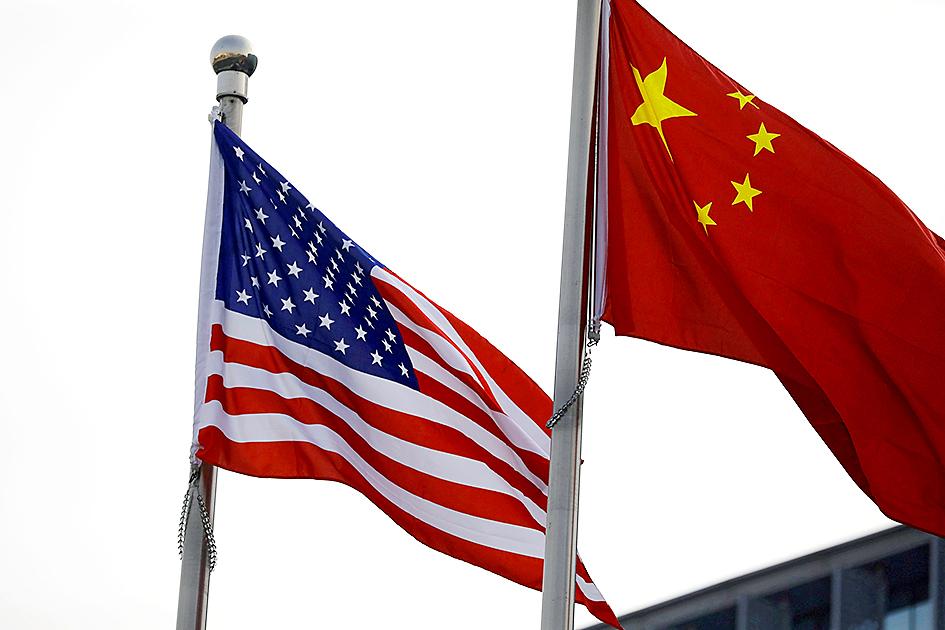By cutting some of its few communication links with the US military, China is raising the risk of an accidental escalation of tension over Taiwan at a critical moment, security analysts, diplomats and US officials said.
China called off planned formal talks involving theater-level commands, defense policy co-ordination and military maritime consultations on Friday as part of its retaliation against US House of Representatives Speaker Nancy Pelosi’s visit to Taiwan this week.
In an editorial yesterday, the Chinese Communist Party’s People’s Daily described the response, along with sanctions against Pelosi and her family, as “effective measures that fully demonstrate that China is fully determined and capable of safeguarding national unity and safeguarding ... sovereignty and territorial integrity.”

Photo: Reuters
US Naval Postgraduate School security expert Christopher Twomey said that the severing of the communication links is worrying, coming at what he believes is the beginning of a new Taiwan crisis.
China fired ballistic missiles over Taipei as part of four days of unprecedented military drills due to end at noon on Sunday.
“This increased density of forces, in the context of an intensifying crisis, raises the prospect for inadvertent escalation that neither side wants,” Twomey said, speaking in a private capacity.
“That is precisely the time you would want to have more opportunities to talk to the other side ... Losing those channels greatly reduces the ability of the two sides to de-conflict military forces as various exercises and operations continue,” he said.
As Chinese warships, fighter jets and drones maneuver around Taiwan, at least four powerful US vessels, including the aircraft carrier USS Ronald Reagan, the amphibious assault ship USS Tripoli and the guided missile cruiser USS Antietam are east of Taiwan, Reuters has confirmed.
Prospects are “extremely low for holding talks on risk reduction measures or stability,” said Bonnie Glaser, director of the Asia program at the German Marshall Fund of the United States.
Glaser said that she expects that the specific talks called off this week would resume over time, but “right now, China has to signal toughness and resolve.”
A US official, speaking on condition of anonymity, said Chinese officials had not responded to calls from senior Pentagon officials this week, but that was seen as China showing displeasure over Pelosi’s trip rather than the severing of the channel between senior defense officials, including US Secretary of Defense Lloyd Austin.
Austin pushed for improved communication between the rival forces when met Chinese Defense Minister General Wei Fenghe (魏鳳和) on the sidelines of the Shangri-la Dialogue security meeting in Singapore in June.
Asian and Western diplomats said that US military chiefs had been pushing for more frequent theater-level command talks for some time, given China’s growing deployments across Asia, where the US navy has traditionally been the dominant power.
The Pentagon said on Friday that China was overreacting, and the US was still open to building crisis communication mechanisms.
“Part of this overreaction has been strictly limiting its defense engagements when any responsible state would recognize that we need them now the most,” Pentagon acting spokesman Todd Breasseale said.

Foreign travelers entering Taiwan on a short layover via Taiwan Taoyuan International Airport are receiving NT$600 gift vouchers from yesterday, the Tourism Administration said, adding that it hopes the incentive would boost tourism consumption at the airport. The program, which allows travelers holding non-Taiwan passports who enter the country during a layover of up to 24 hours to claim a voucher, aims to promote attractions at the airport, the agency said in a statement on Friday. To participate, travelers must sign up on the campaign Web site, the agency said. They can then present their passport and boarding pass for their connecting international

Temperatures in northern Taiwan are forecast to reach as high as 30°C today, as an ongoing northeasterly seasonal wind system weakens, the Central Weather Administration (CWA) said. CWA forecaster Tseng Chao-cheng (曾昭誠) said yesterday that with the seasonal wind system weakening, warmer easterly winds would boost the temperature today. Daytime temperatures in northern Taiwan and Yilan County are expected to range from 28°C to 30°C today, up about 3°C from yesterday, Tseng said. According to the CWA, temperature highs in central and southern Taiwan could stay stable. However, the weather is expected to turn cooler starting tonight as the northeasterly wind system strengthens again

COOLING OFF: Temperatures are expected to fall to lows of about 20°C on Sunday and possibly 18°C to 19°C next week, following a wave of northeasterly winds on Friday The Central Weather Administration (CWA) on Sunday forecast more rain and cooler temperatures for northern Taiwan this week, with the mercury dropping to lows of 18°C, as another wave of northeasterly winds sweeps across the country. The current northeasterly winds would continue to affect Taiwan through today, with precipitation peaking today, bringing increased rainfall to windward areas, CWA forecaster Liu Pei-teng (劉沛滕) said. The weather system would weaken slightly tomorrow before another, stronger wave arrives on Friday, lasting into next week, Liu said. From yesterday to today, northern Taiwan can expect cool, wet weather, with lows of 22°C to 23°C in most areas,

Taiwan sweltered through its hottest October on record, the Central Weather Administration (CWA) said yesterday, the latest in a string of global temperature records. The main island endured its highest average temperature since 1950, CWA forecaster Liu Pei-teng said. Temperatures the world over have soared in recent years as human-induced climate change contributes to ever more erratic weather patterns. Taiwan’s average temperature was 27.381°C as of Thursday, Liu said. Liu said the average could slip 0.1°C by the end of yesterday, but it would still be higher than the previous record of 27.009°C in 2016. "The temperature only started lowering around Oct. 18 or 19